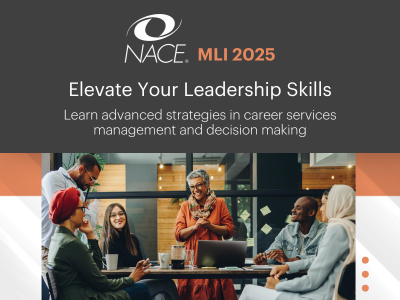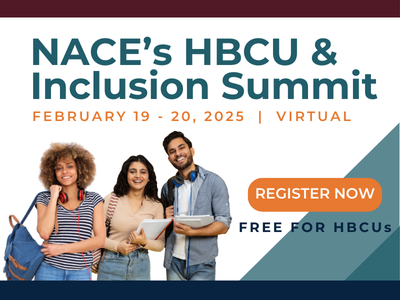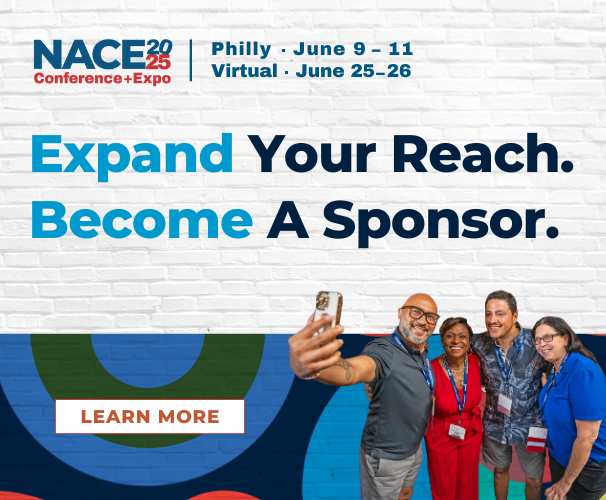Spotlight for Career Services Professionals
How will you bring students back to the career center this fall? If you’re on campus, do you have measures to keep the community safe? If you’re virtual, how will you handle appointments or walk-ins? Here are ideas and plans from members of the NACE Community:
At Stevenson University, north of Baltimore, we plan to open for face-to-face classes. Most of our advising will be remote; if a student wants a face-to-face meeting, we have a few advisers who are able to meet with them with social distance while wearing masks. We are planning some outdoor events with employers—small in scale—such as info sessions and pop-ups on our quad. All other employer-related activities will be remote. Any advising will be done in our conference room across a long table—the offices are too small for social distance. Our classrooms, class assignments, and lab schedules have been modified for social distance. If any in-person advising occurs, we will ask the student to email their materials (resume and cover letter) in advance so there will be no sharing of paper. Advisers can opt for 100% remote advising; individual staff will only be in the physical office one to two days per week to minimize density, while having the office “open.” Fortunately, we have an unusually large office space, and each individual has a private office with a door. We are all prepared to pivot to remote on a moment's notice.
– Susan Gordon, vice president of career services, Stevenson University
I'm not an infectious disease epidemiologist, but I work at the graduate school of public health at Columbia, and we are not allowed to have face-to-face meetings, even if we decided to work in our physical offices. Meetings must still take place via Zoom. If you are in a small, enclosed office, even if you have a window open, you will be sitting two to three feet away from a student. Masks can help, but unless they are fit-tested N-95 masks, virus particles still can escape out of the edges, float around the room, and hang in the air, potentially infecting you and anyone else who spends time in your office for the next two to three hours. This is exactly how this respiratory virus is transmitted: people in close proximity, talking, indoors, for more than 10 minutes. I can't imagine how this is going to be okay unless there are really good masks for everyone, HEPA air filters, and greatly improved ventilation in each room, and every person involved had an instant COVID-19 test before they are allowed entrance into the building. Tests like that don't exist yet.
– Heather Krasna, assistant dean/director, Columbia University – Mailman School of Public Health
Our coaching stations have high walls, and the desk has a plexiglass barrier. Both student and coach will wear a mask. Every student must have an appointment—some will be face-to-face and others virtual. The waiting area only seats three, six feet apart. The student worker stations have plexiglass. There will be no hands-on kiosk or computer self-check-in as we don't have the bandwidth to sanitize. The student will be directed to schedule an appointment on their phone. There are three other areas set up for coaching if the coach does not want to meet in the cubicle. These areas are six feet distant with a plexiglass barrier. These areas could also be used for employer interviews.
– Wendy Flint, director of the IDEA Center (Career & Academic Planning), George Fox University
Missouri State University opened for the Fall 2020 semester with face-to-face courses, blended, and online courses. Students are required to wear masks covering their noses and mouths in any office or academic building. Since last March, our career resources specialists, graduate assistants, and peer advisers have met remotely with students to provide one-on-one document reviews and other career counseling services. If a need arises for us to meet face-to-face with a student, we have a conference room. We created virtual drop-in hours this summer and, while they were not well attended, we are evaluating what time of day we should hold them and anticipate continuing them. In-person, drop-in hours were heavily used in the past during the fall and spring semester and, traditionally, the career center is not terribly busy during the summer, so we don't want to assume that usage this summer is an accurate predictor of what might happen this fall. If you are providing face-to-face workshops, you may be interested to know that in May/June we provided a three-part Instagram Live series to assist students and alumni with searching for jobs during COVID-19. We had never used Facebook or Instagram Live in the past to educate students. It went so well we are going to be hosting Instagram Live discussions twice a month. The first week of the month, we will focus on diversity in the workplace. The third week of the month, we will feature guests talking about other career development topics, such as interviewing and resumes. We also found ourselves recording presentations last spring. This fall, we are providing face-to-face workshops and live Zoom workshops, but we are also gathering information on the videos we already have created and thinking about what videos we should create.
– Jerri Arnold-Cook, career resource specialist, Missouri State University – Springfield Campus
Our university put in place measures to keep our campus community safe (physical distancing whenever possible, facial masks, shields, etc.) and provide hybrid options for all students depending on their level of comfort—appointments/walk-ins in person or via Zoom/phone/email. We are certainly curious about student attitudes given all the safety guidelines, and how they will prefer to interact with our office—e.g., face-to-face with masks and physically distanced, or virtually. Did your office previously host walk-in hours for peer-to-peer reviews? We talked about moving to an appointment-only schedule for our career peers; however, several concerns were raised, one of which was that it would decrease our numbers and frustrate students. I love the idea, but need our staff to buy into it. We have one career peer on duty at a time and our walk-in hours are limited to 11 a.m. - 1 p.m. daily. It's been this way for the past six years and while I would love to move toward the studio model, now does not seem like the right timing.
– Jennifer Fonseca, destiny activator and assistant director of career development, Palm Beach Atlantic University
How will you be serving students this fall? Join the discussion in the NACE Community.







